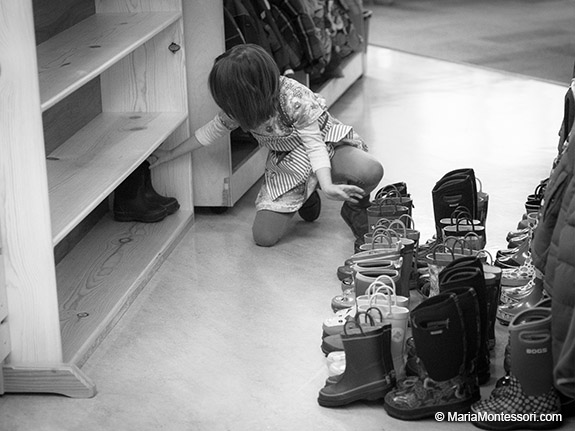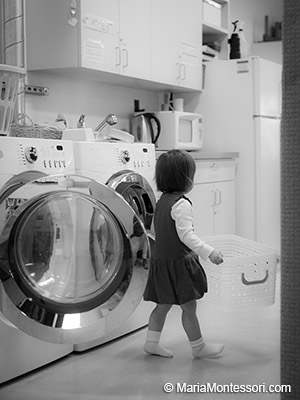
October 30, 2022
In September I was observing a primary class and happened to be present as the teacher gave a lesson to a three-year-old girl on cleaning a chalkboard. They were both wearing aprons, carrying a bucket, sponge, towel, and underlay to a table, and then brought a small, and very dusty, student-size chalkboard to the table, as well. The little girl watched with rapt attention as the teacher dipped the sponge in the bucket of water, squeezed it out, and then began to wipe. As she wiped from left to right across the surface of the chalkboard, it changed from chalky white to dark, shiny green before the child’s eyes.
Once the teacher finished washing and had dried the chalkboard, she turned it over and revealed that the other side was equally chalky. Of course, the little girl could hardly wait to get her hands on the sponge and have a turn. She carefully rinsed the sponge, wiped the chalkboard, and was rewarded with the sight of a clean and shiny chalkboard. Then she dried it and returned it to the shelf for use in writing numbers or letters.
But she wasn’t done. She noticed other chalkboards in need of washing! She repeated the process, washing both sides of three more chalkboards, working and concentrating in total for some 35 minutes. Then she rinsed and squeezed the sponge one more time before returning it to the tray, emptying the bucket into the sink and drying it out, hanging the towel up to dry and replacing it with a dry towel, then returning all of the items to their place on the shelf. She folded her apron, placed it by the tray on the shelf, and with a satisfied smile toddled off to have her snack.
After observing, I knew what I would talk about at the next parent coffee. I borrowed the set-up for washing a chalkboard from one of the primary classrooms and gave the parents a demonstration of its use. I asked one of the parents to count the steps involved, and he noted 21. The parents agreed that’s a lot of steps for a 3-year-old to execute in sequence! But they still wondered, what is the point of all this?
It is three-fold. First, it’s hard to get out of sequence in practical activities and it is immediately apparent if you do – you can’t dry the chalkboard before you wipe it, can you? This is one reason we give so many practical life activities to the toddler and primary children, so they can learn to pay attention to and carry out an elaborate sequence of steps successfully, because in later math and language work the sequence of steps can be even more elaborate, but not at all obvious. It’s an important skill to have already developed before one does multiplication with the bead frame or long division with the racks and tubes!

Secondly, because of the obvious change in the surface of the chalkboard itself as the child is wiping it, a practical life activity such as washing a chalkboard calls forth the intense focus that the little girl exhibited, perhaps for the first time. It is often in the exercises of practical life that the child’s attention is captured, and in which the ability to focus, concentrate and repeat is first developed.
The satisfied smile on the little girl’s face as she completed her self-appointed task, was an indication of the third benefit of practical life activities: they contribute marvelously to a child’s sense of responsibility and accomplishment, thus building self-confidence and self-esteem.
So far I had only talked about practical life in toddlers and primary, but what about elementary children? It’s in elementary that the children really take on the day-to-day responsibility for the care of the classroom environment, develop and care for vegetable gardens, and provide practical service to the younger classes in the school. It is elementary children who put out the nap mats daily in the toddler classes. It is elementary children who purchase and distribute the crickets, grain, mealworms, and food pellets that feed the fish, amphibians, reptiles, birds, and mammals that live in the cages, terrariums, and aquariums of the younger classes. It is elementary children who order and distribute the pizza that all of the children can choose every Wednesday!
Elementary students also take responsibility for the planning and execution of any number of trips for small group research at zoos, museums, libraries, and commercial enterprises in the local area that we call “going outs.” This important aspect of practical life in elementary culminates in the planning and execution of a trip to Washington D.C. in their final year. And what is more practical than the various fundraisers – breakfast burritos, spaghetti dinners, and garage sales — that pay for that trip?
According to Dr. Adele Diamond, Professor of Developmental Cognitive Neuroscience at the University of British Columbia, all of these skills — the discipline to stay focused, seeing tasks through to completion, concentrating, planning and practical problem-solving – are referred to as “executive functions.” It is no wonder that in a study comparing children chosen by lottery to enter a Montessori public school to those also in the lottery but not chosen, the Montessori children showed significantly better executive function skills at the end of sixth grade.
To quote again from Dr. Diamond, “executive functions are more important for school readiness than IQ, continue to predict math and reading competence throughout all school years, and remain critical for success throughout life including career and marriage, and for positive mental and physical health.” Wow! Career and marriage? Positive mental and physical health? From the humble beginnings of washing a chalkboard come to some really great things!